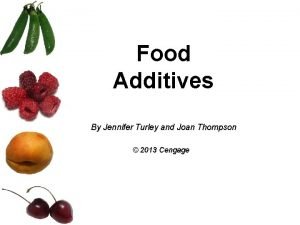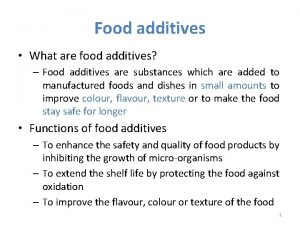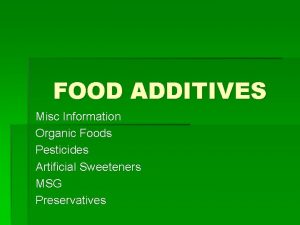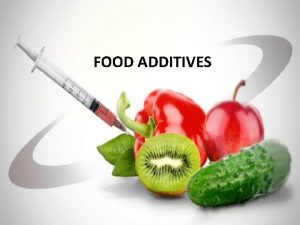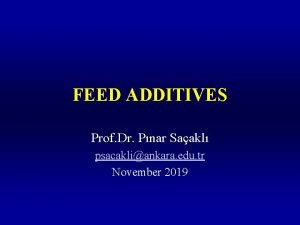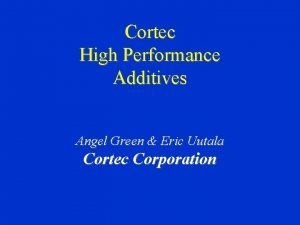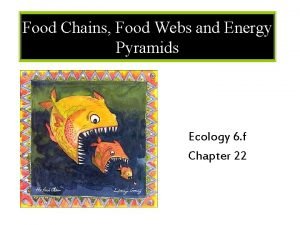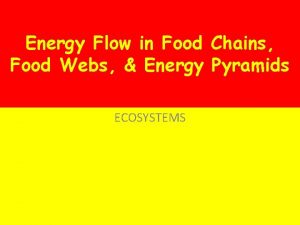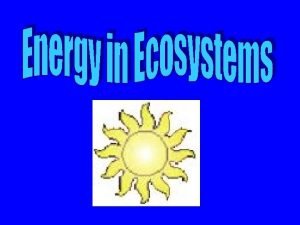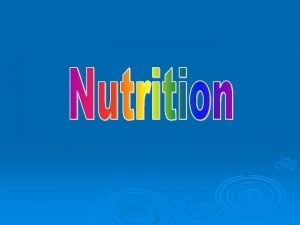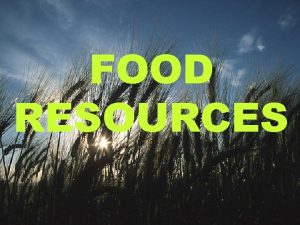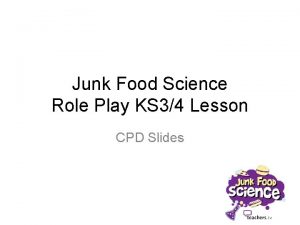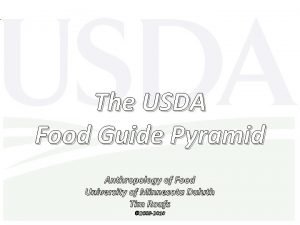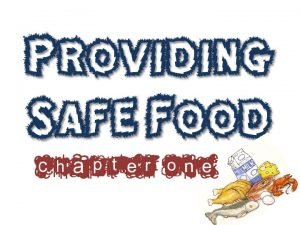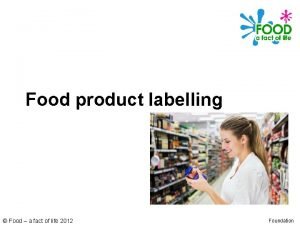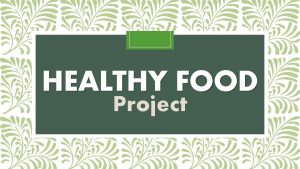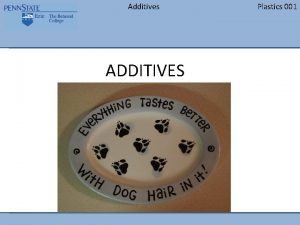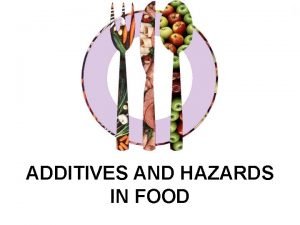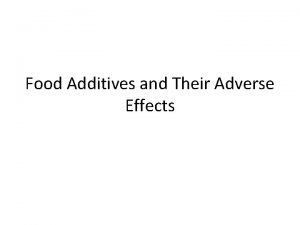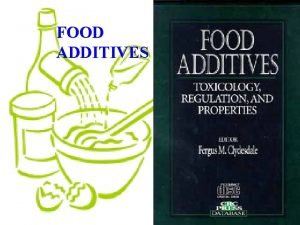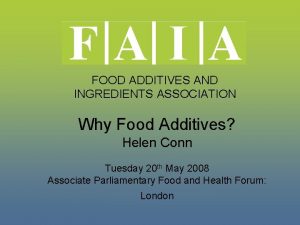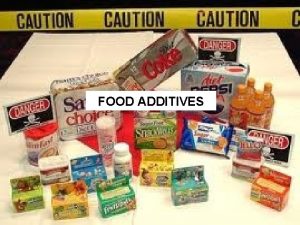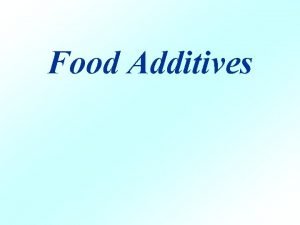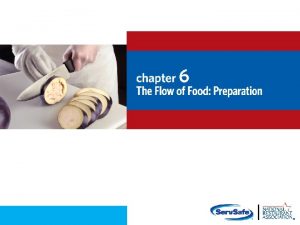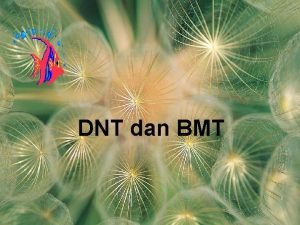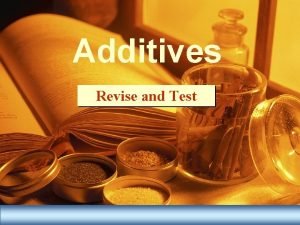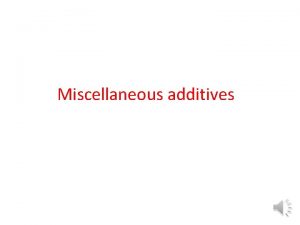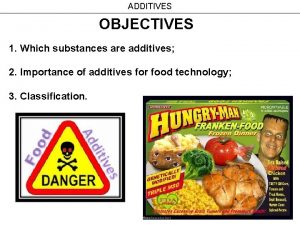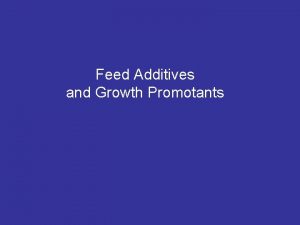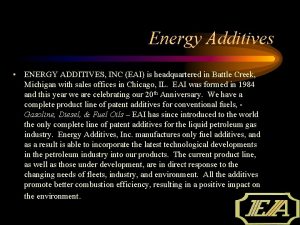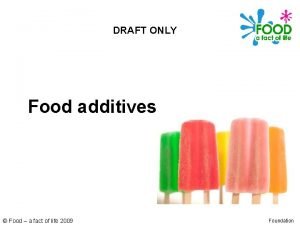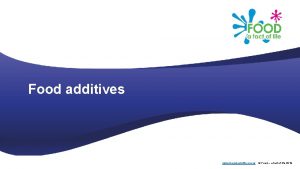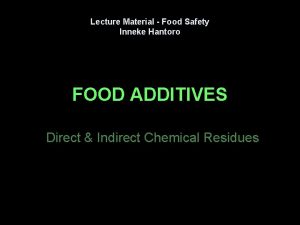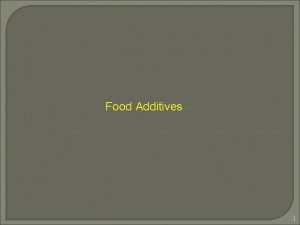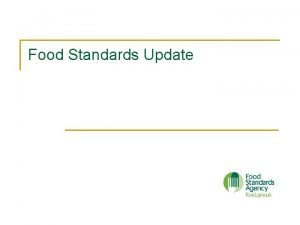Food additives What are food additives Food additives
































- Slides: 32

Food additives • What are food additives? – Food additives are substances which are added to manufactured foods and dishes in small amounts to improve colour, flavour, texture or to make the food stay safe for longer • Functions of food additives – To enhance the safety and quality of food products by inhibiting the growth of micro-organisms – To extend the shelf life by protecting the food against oxidation – To improve the flavour, colour or texture of the food 1

Food labelling and food additives • All additives must be listed on food labels • The names (or the identification number) and the functions of the additives used in a prepackaged food must be listed on the food label • Additives must appear on the food label in descending order of quantity (greatest amount first) • International Numbering System for food additives – It is an internationally agreed numerical system for identifying food additives • E number – Additives are given the prefix “E” if they have been accepted as safe for use within the European Union 2

Food labelling and food additives 2 labelling formats of food additives: Functions and identification numbers of food are listed on the food label Functions and names of food are listed on the food label Ingredients: Water, sugar, tea, lemon juice, flavouring, acidity regulator (330 and 331), vitamin C, antioxidant (304) Ingredients: Organic pomegranate concentrate, organic cane sugar, organic pomegranate juice, apple pectin, ascorbic acid (vitamin C) & citric acid (acidity regulators) 3

Food additives • 3 groups of food additives: – Natural: obtained from natural sources, e. g. • colouring made from carotenes (E 160 a(ii)) – Synthetic (nature identical): made in a laboratory to be chemically the same as certain natural materials , e. g. • synthetic colouring of carotenes (E 160 a (i)) – Artificial: synthetic compounds that do not occur in nature, e. g. • saccharin (E 954), a low-calorie sweetener 4

Types of food additives and their functions • The main functional classes of food additives are: – – Colourings Flavourings and flavour enhancers Sweeteners Emulsifiers and stabilisers – Preservatives – Antioxidants 5

Colourings • Colours are used to: – Make food look more attractive and replace the colours lost during the processing of food – Maintain consistency between different batches of production Ingredients: Pork, egg protein, milk protein, salt, soy protein, pork collagen, yeast extract, flavour enhancer (E 621), acidity regulatory (E 339), antioxidant (vitamin C), colour (E 120), colour retention agent (E 250), sweetener (E 950, E 955), spice Use of colouring (E 120 Carmines ) in pre-packed ham 6

Flavourings and flavour enhancers • Flavourings and flavour enhancers are used to: • Increase and improve the taste of foods, e. g. • Monosodium glutamate (MSG) is a well known flavour enhancer to make the flavour of food stronger • Replace the flavours lost during the processing of food Ingredients: preserved mustard, salt, flavour enhancer (E 621 Monosodium glutamate), chilli, rapeseed oil, spices, white sugar, acidity regulator (E 330 citric acid). Use of flavour enhancer (E 120 Carmines ) in pickled tuber mustard 7

Sweeteners • Sweeteners enhance the sweetness in food – Usually much sweeter than natural sugar – Used in tiny amounts to sweeten drinks and other foods • They are very low in energy so they are often used in low -calorie drinks and reduced sugar products aimed at people who are trying to lose weight • Examples of commonly used sweeteners: – – Acesulfame K (E 950) Aspartame (E 951) Saccharin (E 954) Sucralose (E 955) 8

Sweeteners Comparison between normal coke and low-calorie coke Ingredients: carbonated water, sugar, colour (150 d), acidity regulator (338) , caffeine and other flavourings Use of sugar in normal coke Ingredients: carbonated water, colour (150 d), acidity regulators (338, 331) , sweeteners (951, 950, 955), flavourings, preservative (211), caffeine Use of aspartame (951), acesulfame K (950) and sucralose (955) in low-calorie coke Normal coke Low-calorie coke 9

Emulsifiers and stabilisers • Emulsifiers and stabilisers are used to – Improve the consistency of food during processing and storage – Mix ingredients like oil and water that normally separate • Example of emulsifier: – Lecithin in egg yolk is a natural emulsifier that holds oil and water together and prevents them from separating out 10

Emulsifiers and stabilisers • The oil and vinegar (which contains water) in mayonnaise are prevented from separating by the egg yolk Ingredients: soybean oil, water, eggs, vinegar, sugar, salt, egg yolks, natural flavour (contains mustard), lemon juice concentrate, preservative (E 385), dried garlic, dried onions, paprika 11

Preservatives • Preservatives are used to prevent or slow down the growth of micro-organisms • Preservatives avoid wastage of food by extending their storage period (shelf-life) • Examples of preservatives: – Salt, sugar, vinegar are common household preservatives – Sulphur dioxide is used to prevent discolouration of food – Nitrates and nitrites are used for curing of meat 12

Antioxidants • What is antioxidant? – Any substance that protect food from deterioration caused by oxidation (e. g. browning of food) • Antioxidants are used to: – Prevent fat-soluble vitamins (vitamin A and D), oils and fats in food from going rancid • Rancid is the development of an unpleasant smell and taste due to the reaction between oxygen and fat – Prevent browning of cut fruits e. g. apples and pears when they are exposed to air 13

Antioxidants • Examples of antioxidants: – Vitamin C (also known as ascorbic acid) is one of the most widely used natural antioxidants Experiment 1. Cut the banana, leave some slices in air and immerse other slices into lemon juice 2. Observe the colour change after 5 and 60 minutes After 5 mins Air Lemon juice After 60 mins Air Lemon juice Ascorbic acid in lemon juice inhibits enzymatic browning 14

Common preservatives and antioxidants used: Sulphur dioxide and sulphites • Functions of Sulphur dioxide – Antimicrobial action: it inhibits the growth of bacteria and moulds but not yeasts – Antioxidant: it also inhibits browning reactions • Sulphur dioxide appears on food labels under several names: Sulphur dioxide (E 220) Sodium sulphite (E 221) Sodium bisulphite (E 222) Sodium metabisulphite (E 223) Potassium metabisulphite (E 224) Potassium sulphite (E 225) 15

Common preservatives and antioxidants used: Sulphur dioxide and sulphites • Sulphur dioxide is commonly used to preserve a wide range of foods, e. g. – Inhibit the growth of yeasts and bacteria in dried fruits, pickled vegetables and meat – Delay the discolouration in meat, fruits and vegetables caused by oxidation – Prevent further fermentation of sugar by residual microorganisms in wine • What is fermentation? Fermentation by yeasts – Fermentation is the breakdown of sugar into an alcohol or an acid by micro-organisms, e. g. bacteria and yeasts 16

Examples of food with sulphur dioxide/ sulphites added: Ingredients: Mangoes, sugar, salt, preservative (E 223) Ingredients: Selected mangoes, sugar & preservative (sulphur dioxide) Ingredients: Mangoes, sugar, sodium metabisulphite Ingredients: Dried apricots, sulphur dioxide added as a preservative 17 Use of sulphur dioxide and sodium metabisulphite (E 223) in dried mangoes and apricots

Examples of food with sulphur dioxide/ sulphites added: Ingredients: Vegetables in variable proportions, sugar, water, barley malt vinegar, spirit vinegar, chopped dates, salt, apple (contains preservative: sodium metabisulphite), modified maize starch, tomato paste, color: sulphite, ammonia caramel, spices, lemon juice concentrate, onion powder, flavourings Use of sodium metabisulphite and sulphite in pickled vegetables Ingredients: Prepared lima beans, water, salt, antioxidants (calcium disodium EDTA, sodium sulphite), firming agent (calcium chloride) Use of sodium sulphite in preserved butter beans 18

Common preservatives and antioxidants used: Sulphur dioxide and sulphites • Health effects: – Sulphur dioxide is generally of low acute and chronic toxic effects – Sulphur dioxide may induce allergic reactions e. g. asthmatic attacks, headache and nausea in susceptible individuals • People with history of allergy should read food labels of pre-packaged food carefully to avoid intake of certain preservatives 19

Common preservatives and antioxidants used: Sulphur dioxide and sulphites • In Hong Kong, Sulphur dioxide is not permitted to be used in fresh or chilled meat – Sulphur dioxide stops the oxidative process of meat and retain the desirable fresh meat colour Without sulphur dioxide used With sulphur dioxide used 20

Illegal use of sulphur dioxide in beef Source: local newspapers (integrated report), November 2014 21

Common preservatives and antioxidants used: Nitrates and nitrites • What are nitrates and nitrites? – Nitrates are naturally occurring compounds – Nitrates and nitrites compounds are added to cured meat (e. g. sausages, ham, bacon, luncheon meats) to preserve the red colour of meat and to inhibit the growth of bacteria – They appear on food labels under several names: Potassium nitrite (E 249) Sodium nitrite (E 250) Sodium nitrate (E 251) Potassium nitrate (E 252) 22

Examples of food with nitrates and nitrites added: Ingredients: Pork, egg protein, milk protein, salt, soy protein, pork collagen, yeast extract, flavour enhancer (E 621), acidity regulatory (E 339), antioxidant (vitamin C), colour (E 120), colour retention agent (E 250), sweetener (E 950, E 955), spice Ingredients: Pork, chicken, water, cheddar cheese, onion, tapioca starch, soy protein, dextrose, salt, sugar, flavour [salt, spices, paprika extracts, acidity regulator (575), spices, antioxidant (300, 301), flavour, glucose syrup, flavour enhancer (621, 631), dextrose, vegetable oil], garlic, spices, flavour enhancer (621), emulsifier (450, 451), milk protein, colour (102, 124), colour retention agent (E 250) Use of sodium nitrite (E 250) in ham and sausage 23

Examples of food with nitrates and nitrites added: Ingredients: Pork, ham, starch, salt, sugar, spices, colour retention agent (sodium nitrite) Use of Sodium nitrite in luncheon meat 24

Common preservatives and antioxidants used: Nitrates and nitrites • Health effects: – Under normal consumption, nitrites are unlikely to cause acute health effects – Long term excessive intake of nitrites may increase the risk of cancer • Ingested nitrite will be converted to nitrosamines in the stomach • Nitrosamines are known to be carcinogenic 25

Common preservatives and antioxidants used: Nitrates and nitrites • What is carcinogen? – Carcinogen is a substance that can cause cancer, e. g. • aflatoxins in contaminated peanuts is a carcinogen associated with liver cancer; • certain nitroso compounds e. g. nitrosamines, resulted from ingested nitrate is associated with stomach cancer 26

Common preservatives and antioxidants used: Nitrates and nitrites Facts or Myths? Reheat cooked vegetables is carcinogenic? • Nitrates are used as fertiliser in many countries • Nitrates are also naturally found in vegetables e. g. spinach, cabbage, etc. • Improper storage of cooked vegetables lead to excessive growth of micro-organisms and increase the subsequent conversion of nitrate to nitrite in the vegetables 27

Common preservatives and antioxidants used: Nitrates and nitrites Facts or Myths? Reheat cooked vegetables is carcinogenic? • Conversion of nitrate to nitrite in vegetables: – Nitrate is naturally converted to nitrite by enzymes in vegetables – Bacterial action on vegetables causes accumulation of nitrite before and after cooking Potent carcinogen 28

Common preservatives and antioxidants used: Nitrates and nitrites Facts or Myths? Reheat cooked vegetables is carcinogenic? • Key steps to reduce nitrate/nitrite intake from leafy vegetables: To reduce the – Store fresh and cooked vegetables in conversion of refrigerator nitrate to nitrite by – Cook vegetables soon after chopping enzymes or – Blanch vegetables in boiling water bacteria 29

Common preservatives and antioxidants used: Acetic acid • Usually appears on food labels under several names: Acetic acid (260) Vinegar (4% acetic acid) Sodium acetate (262(i)) Potassium acetate (261(i)) Calcium acetate (263) • Added to mayonnaise, pickles to prevent microbial growth and contribute to flavour 30

Examples of food with acetic acid added Use of acetic acid in sauces: Ingredients: Water, tomato paste, white sugar, salt, modified corn starch, acidity regulator (E 260), flavouring, onion powder, naturally present sulphites Ketchup Ingredients: Water, sugar, red chilli, garlic, salt, thickener (E 1422), acidity regulator (E 260) Chicken sauce Ingredients: White sugar, fermented soybean paste , soy sauce, water, tomato paste, salted plums, salted chilli peppers, soybean oil, modified corn starch, dehydrated garlic, sesame oil, colour (E 150 c), acid (E 260), spices, flavour enhancers (E 631, E 627) Sauce for beef ribs 31

Examples of food with acetic acid added Ingredients: soybean oil, water, eggs, vinegar, sugar, salt, egg yolks, natural flavour (contains mustard), lemon juice concentrate, preservative (E 385), dried garlic, dried onions, paprika Use of vinegar in mayonnaise Ingredients: Cucumbers, sugar, water, distilled vinegar, salt, acetic acid, calcium chloride, alum, polysorbate 80, natural spice, flavours Use of vinegar and acetic acid in pickled cucumber 32
 Insidan region jh
Insidan region jh Jennifer joan thompson
Jennifer joan thompson Natural and artificial food additives
Natural and artificial food additives Food additives examples
Food additives examples Food technology revision
Food technology revision Msg pesticide
Msg pesticide Food additives definition
Food additives definition Feed additives classification
Feed additives classification Enemas are the liquid dosage forms used for
Enemas are the liquid dosage forms used for High performance additives
High performance additives Example of plasticizer
Example of plasticizer Colors of regulation
Colors of regulation Food safety and inspection service definition
Food safety and inspection service definition Grazing food chain diagram
Grazing food chain diagram Unit 2 food food food
Unit 2 food food food Deciduous forest energy pyramid
Deciduous forest energy pyramid Explore food.foodafactoflife
Explore food.foodafactoflife Food chain and food web examples
Food chain and food web examples Ladybug food web
Ladybug food web Food scientists measure food energy in
Food scientists measure food energy in When should hand antiseptics be used
When should hand antiseptics be used Changes caused by agriculture and overgrazing
Changes caused by agriculture and overgrazing Role play on healthy food and junk food
Role play on healthy food and junk food Food chain energy flow
Food chain energy flow Alligator food chain
Alligator food chain Food groups pyramid
Food groups pyramid Food chain
Food chain Gets its energy from eating living things
Gets its energy from eating living things Importance of food
Importance of food Food a fact of life
Food a fact of life Which is a tcs food bread flour sprouts strawberries
Which is a tcs food bread flour sprouts strawberries Role play on healthy food and junk food
Role play on healthy food and junk food Junk food vs healthy food project
Junk food vs healthy food project

